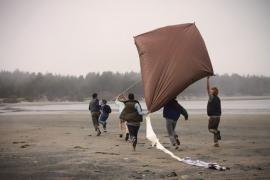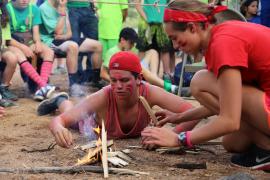Youth development is a complicated process, and the support of it in diverse populations is even trickier. There is no "magic bullet" to solve the dilemma of how best to support youth as they mature into adults. The magic seems to be that adults, such as camp professionals, care enough to continue seeking ways to design programs that offer support as youth move through the process. The features of positive youth development identified by the Committee on Community-Level Programs for Youth (Eccles & Gootman, 2002) were introduced in the last Research Notes Column (Powell & Scanlin, 2002), and in this column, the concepts will be applied to staffing and program - specifically program planning as a matrix web, staff supervision through the lens of the youth development features, and a twist on comprehensive program evaluation.
Planning as a Matrix Web
After examining the features individually - physical and psychological safety, appropriate structure, supportive relationships, opportunities to belong, positive social norms, support for efficacy and mattering, opportunities for skill building, and integration of family, school, and community efforts - another angle from which to approach evaluation is to visualize the features as points on a web (see the figure on page 65). Using specific programs or actions as the connections between the features, think about ways to coordinate and reinforce efforts to help move youth forward across job functions in your camp.
Just as when pressure placed on one part of a spider's web can affect the entire web, one small change in youth development programs from a systemic viewpoint, can send vibrations throughout the entire organization. For example, what are the areas of your program that support more than one feature? Some of the features build on the elements of the others . . . intentional focus on positive social norms that include support for efficacy and mattering may lead to opportunities to belong and supportive relationships. Skill-building opportunities that include interpersonal skill building as well as program skills may lead to psychological safety for all community members. Appropriate structure may lead to both physical and psychological safety that makes it easier for youth to belong - thereby fostering supportive relationships that can serve as models for behavior back home or at school. So after looking at each feature individually, the next step is to address the synergy possible by looking for the connections between the program elements and the features embedded in them.
From a systemic viewpoint, camps offer possibilities that do not exist in many school systems. As adolescents' developmental needs are changing, they often shift from a smaller to a larger school - a setting with less personal contacts with adults and less opportunity to engage in activities (Eccles & Gootman, 2002). Camp has the potential to increase the personal attention and engagement levels through the types of programs and leadership offered in a setting without curriculum demands. The ability to engage youth in programs, roles, and responsibilities that allow them to be central in the life and function of the camp takes concerted effort from many directions.
Have you considered bringing staff members who address those different program areas together to talk about supportive relationships? For example, are there ways to encourage activity skill instructors to actively discuss group dynamics as part of their program? Are there ways that the food service department can support the theme of teamwork in the type of meal served or maybe in the way that it is served (could it take teamwork on the part of the campers to complete the meal)? In what ways could the maintenance staff support the arts and crafts instructor? Could the room be designed so the instructor is in the middle and can easily reach all of the work areas to support the children? The point being - in the business of camp - sometimes the single-mindedness of a department or staff function could limit the creative potential for all the departments. The extra time to think about cross-functional potential could lead to more synergistic solutions to daily functions and implementations.
What area is supportive of one feature but hinders another feature because of the implementation method? For example, strict limitations and over-controlled leadership may attain physical safety, but that positive feature may be to the detriment of appropriate structural and supportive relationships among staff. Does the physical structure of a building play a role in how the activities flow with campers? An interesting slant toward the implementation process comes from the application of a developmental psychology concept in the field of landscape architecture.
The idea of "affordances" in relationship to children's environments (Gibson, 1982) fits hand-in-hand with the features of positive youth development. Both are seeking to increase the potential for success of participants by focusing on the possibilities and potentials that need to be in place to promote positive youth development. The basic idea of affordances in terms of the physical environment for play, as expanded by Heft (1985), reverses the focus on the physical environment as a backdrop and places the possibilities for "a place" at the forefront of program implementation.
Often in program design, the environment is scanned for potential risk management hazards, but through the lens of affordance, the environmental scan results in possibilities and potential for what the children can "do" in an experiential sense and creates a physical and psychological habitat (Barker & Wright, 1955). Synthesizing the creative potential of people, places, and things generates local opportunities to capitalize on the innovation that exists literally around the corner . . . and in the modern world; the peek around the corner could literally be to the other side of the world!
Staff Supervision
The best-laid program planning can be torpedoed or strengthened by the staff that plan and implement it. While there is no substitute for staff who bring maturity, sensitivity, and appropriate values to the job, using the features of positive youth development as a framework for interviews, job descriptions, observations, and job performance feedback conferences is a step in taking the outcomes expected for campers and placing the outcomes at the forefront of the staffing process. How can the knowledge of these features and their resulting web of support impact your staff-supervision process from beginning to end?
Pull out your current interview protocol. What questions do you ask that probe the applicant's background relative to promoting positive youth development and go beyond asking about program skills and work experience? Challenge yourself and staff to generate interview questions that allow for investigation of each feature - and a few that capture the element of the web design of support across the features.
For example: 1) "I see that you have experience teaching archery. In what ways could you teach that activity to increase a camper's sense of belonging and sense of self-efficacy?" You are communicating that your camp does not teach an activity just for the program's skill-building opportunity, and thus you are challenging the potential staff member to see beyond their skill area. 2) "Describe the emotional climate in the after-school program where you worked. What role does the counselor have in creating a positive climate for all of the participants? What have you personally done to affect change in the emotional climate of a youth development setting?" Here you are able to listen for descriptors that provide evidence of perception on the part of the staff member, and then an opportunity to hear and reinforce the role the adult has in fostering positive behavior and interrupting negative behavior.
The challenge of writing detailed job descriptions that clearly communicate the expected staff role can be supported by examining the overall message of the description in light of your mission and outcomes for campers. An attempt to integrate the features with job functions and the resulting staff behaviors may trigger further ways to provide intentional support for youth development at all levels of the camp community.
When writing a job description, consider the following examples of job features and corresponding functions:
- physical and psychological safety - facility arranged and equipped for safety, flow of activities encouraged warm-up and transitions;
- appropriate structure - controlled the group without domineering, handled contingencies and interruptions, managed time effectively;
- supportive relationships - expressed enthusiasm for the activity leading; encouraged students to participate; showed universal respect for participants; acted as a role model, showing respect for peers andco-workers; responded to questions in supportive manner; encouraged engagement; laid out expectations; followed through in line with articulated expectations; and
- opportunities for skill building - confirmed knowledge in activity area; presented clear, concise, andage-appropriate directions; broke down steps for easier acquisition.
The inclusion of staff behaviors in job descriptions then serves as a springboard to effective observations by peers and supervisors, and provides a youth development focus to performance review conferences.
Comprehensive Evaluations
The crafters of the features for positive youth development visualized them as continuums and did not consider the report to be a conclusive finished document. Rather, they envisioned it as a starting point for local and international discussions about how to best support youth development. By structuring an in-depth evaluation of your program around these features and asking questions about how best to support youth development, you are initiating the journey.
Six questions are offered by the committee to investigate your program:
- Is the theory of the program that is being evaluated explicit and plausible?
- How well has the program theory been implemented in the sites studied?
- In general, is the program effectiveand, in particular, is it effective with sub-populations of young people?
- Whether it is or is not effective, why is this the case?
- What is the value of the program?
- What recommendations about actions should be made?
(Eccles & Gootman, 2002, p. 206)
Specific to summer camps, the questions are to be asked in the specific order and flow from general to specific questions:
- What are the goals, objectives, and expected outcomes of the program (program theory)? What are you trying to accomplish and how do you plan to implement the levels of goals and objectives so that the campers achieve the outcomes?
- How well have you been able to implement the plan? Is it working with some cabin or program groups, but not others? Working some weeks, but not others? Working well at some sites and not others? Is there a difference in how it is being implemented?
- Is the program effective for all ages, races, and socio-economic levels? Are there subsets of your populations that seem to have more trouble than others achieving the desired outcomes?
- Why has the implementation been successful or not? What are the causes, what are the differences, what is working, and what is not?
- What is the overall value of your program or of the specific sub-programs your agency offers?
- Based on the answers to the above questions, what are the specific recommendations for action . . . moving beyond the "diagnosis" on to the action to be taken? These actions may be systemic or targeted to a specific program or population.
Learning more about ways to structure evaluations around the web of support possible through promoting positive youth development at a deep, systemic level in camp and sharing those results has potential to increase our ability to help the campers we serve . . . to use their character skills gained in life and supported by camp to successfully navigate the transition into adulthood. Camp can play an important role in that process, and steps to intentionally support the development can increase our ability to do so.
References
- Barker, R.G. & Wright, H.F. (1955). Midwest and its children: The psychological ecology of an American town. Evanston, IL: Row, Peterson & Co.
- Eccles, J & Gootman, J.A. (Eds). (2002). Community Programs to Promote Youth Development. National Research Council and Institute of Medicine. National Academy Press: Washington, D.C. The report is available as an "open book" online at: www.nap.edu/catalog/10022.html.
- Gibson, E.J. (1982). The concept of affordances in development: The renascence of functionalism. In W.A. Collins (Ed.), The concept of development: The Minnesota symposium on child development. Vol. 15. Hillsdale, NJ: Lawrence Erlbaum.
- Heft, H. (1985). High residential density and perceptual-cognitive development: An examination of the effects of crowding and noise in the home. In J.F. Wohlwill & W. van Vliet (Eds.) Habitats for children: The impacts of density. Hillsdale, NJ: Lawrence Erlbaum.
- Powell, G.M. & Scanlin, M. (2002). Ways to promote youth development in camp. Camping Magazine, 75 (5), 14-17.
Gwynn M. Powell, Ph.D., is an assistant professor in the Department of Recreation and Leisure Studies at the University of Georgia.
Originally published in the 2003 January/February issue of Camping Magazine.



